Index
Introduction
Definitions
-
Information Security
The practice of preventing unauthorised access, use, disclosure, disruption, modification, inspection, recording or destruction of information. -
Threat Agent:
An entity who can manifest a threat. It could be internal or external to the organisation or network. -
Threat:
A threat is a potential cause of an incident that may result in harm to a system or organisation (ISO 27002).In other words, what can go wrong and how can it hurt the organisation?
This includes a number of categories, such as rootkits, backdoors, malware, natural disasters, etc.
-
Vulnerability:
A vulnerability is a weakness of an asset or a group of assets that can be exploited by one or more threats (ISO 27002). This may be in a procedure, hardware or software.In other words, a vulnerability tells us why an asset is not protected from a threat.
-
Risk:
A risk is the potential that a given threat will exploit vulnerabilities of an asset or a group of assets and thereby cause harm to the organisation (ISO 27002).We could also view this as the likelihood of a threat agent taking advantage of a vulnerability and the resultant impact to the organisation’s assets.
-
Impact:
The impact is the result of a risk materialising, caused by a threat, which affects assets (ISO 27005).In other words, if the asset is exploited, what is the real cost to the organisation?
-
Safeguard:
Also known as risk treatment action, safeguards can be used to mitigate, transfer or remove the threat altogether.
Relationship
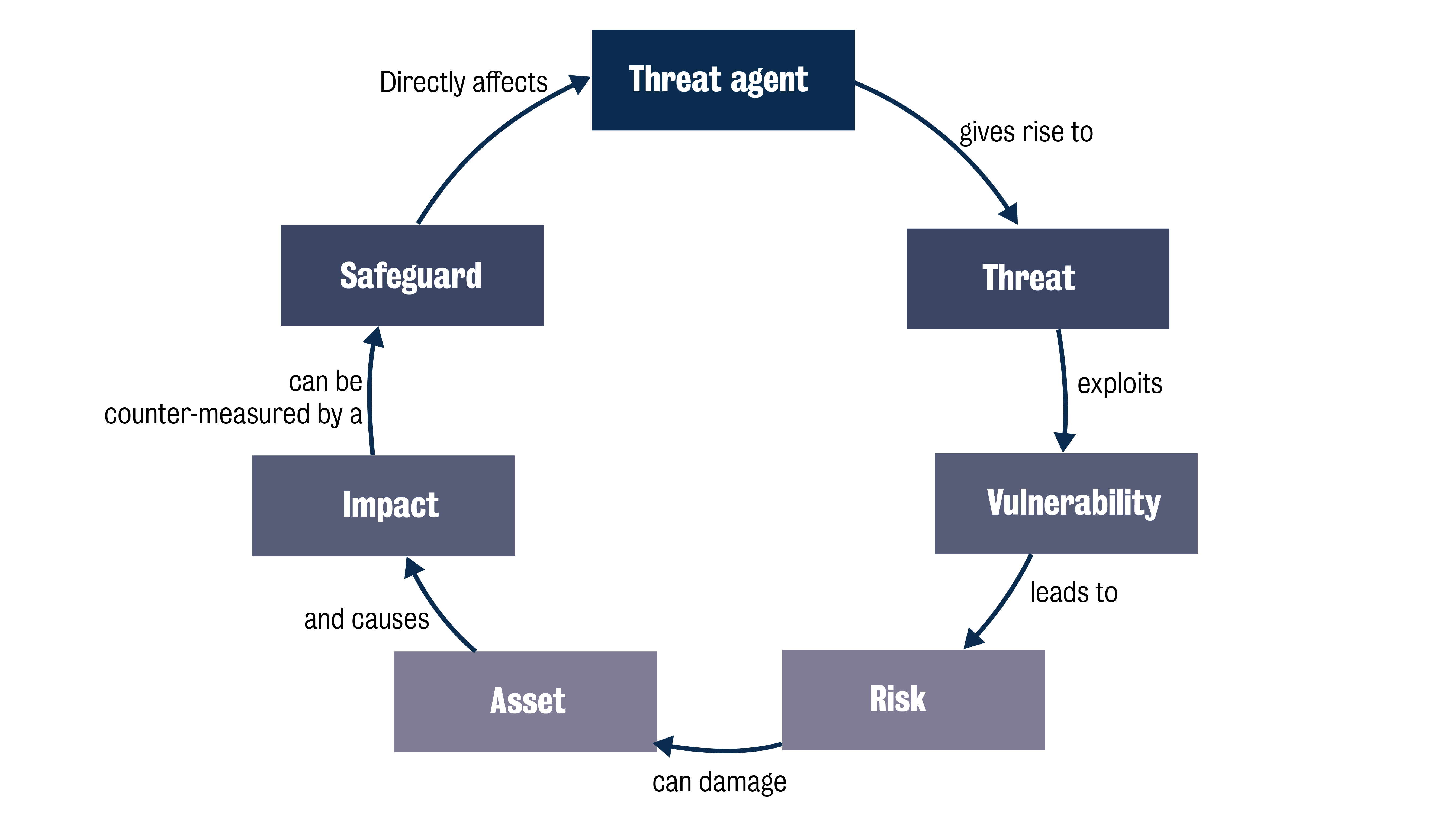
Risk Management
- Definition
Coordinated activities to direct and control an organisation with regard to cyber security risks (ISO27005).
Risk management ensures that security measures are:- relevant
- timely
- responsive to threats
- cost-effective.
- Lifecycle and steps
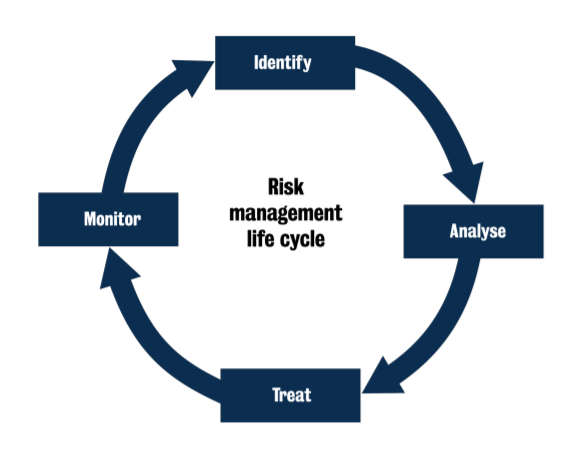
-
Asset Identification
Analysis of the main organisation assets and the value they have for the organisation. This is crucial to be able to understand and analyse the impact of a risk in an organisation. -
Threat Assessment
Analysis of which entities could pose a threat to the organisation, so as to understand them better and be able to ascertain what they would like from an organisation. -
Vulnerability Assessment
Testing of the organisation’s systems, policies, procedures and physical environment to determine socio-technical and physical vulnerabilities that threats could exploit. -
Risk Assessment
Combination of the three previous analyses to analyse the risks the organisation faces. -
Risk Treatment
A consideration of the best course of action (Reduce, Transfer, Avoid or Accept the risk) to mitigate a risk, based on the risk analysis. -
Risk Monitoring
A process of continuously updating the previous analyses to identify changes in terms of assets, threats, vulnerabilities and resulting risks, in order to determine whether the risk treatment needs to change.
Asset categories
- Pure Information
- Physical Assets
- Software
Threat and Vulnerability Assessment
Asset valuation
The value of an asset is prioritised by the contribution it makes to the business. This may include:
- how it contributes to security properties – eg CIA and other requirements (eg non-reputation)
- information classification policies (public vs highly sensitive information)
- cost of compromise (replacement equipment)
- interdependencies with other business systems/processes
- personal injury or death.
Threat Assessment
Threat assessment identifies the threats to an organisation, and identifies the likely culprits of attacks.
Threat Agents
The threat agent is someone or something that may give rise to a threat. It is the likely culprit of a risk to the organisation. Threat agents can be natural, accidental, or malicious.
- Natural Threats
- Accidental Threats
- Malicious Agents
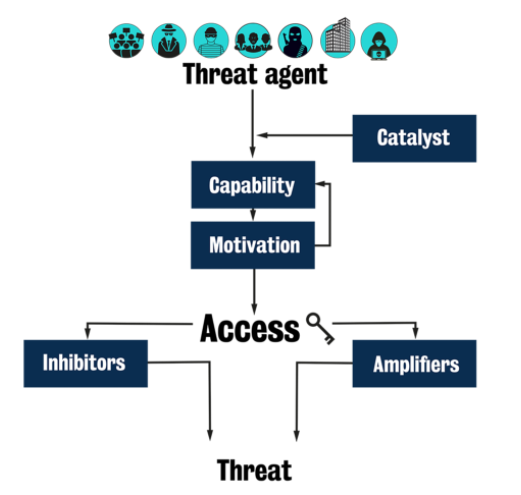
Threat agent Characteristics:
- Motivation - Why are they doing this?
- Capability - Can they do it and to what level?
- Catalyst - What set them off?,
- Inhibitors - What has/could put them off?
- Amplifiers - What has/could push them on?
Threat Assessment Methodology
Formula:
$TC = (Q * 4) + (T * 3) + (H * 7) + (U * 6) + Pr$
| Factor\Score | 1 | 2 | 3 | 4 | 5 | 6 |
|---|---|---|---|---|---|---|
| Group Size (Q) | 1-25 | 26-50 | 51-100 | 101-200 | 201-300 | >300 |
| History of relevant activity (H) | None | Intermittent | Occasional | Occasional | Regular | Regular and widespread |
| Technical expertise (T) | None | Very limited | Limited | Limited | Adequate | High level |
| Prowess within community (Pr) | Not part of a group | Peripheral interest | Interest within group | Significant within group | Important within group | Very important within group |
| Reason for target selection (U) | Curiosity | Rebellion | Criminal Gain | Criminal Gain | Belief | Revenge, religion, racism, nationalism |
Vulnerability Assessment
Vulnerability categories
- Technical Vulnerabilities
- Hardware Vulnerabilities
- Application Vulnerabilities
- System Configuration
- Social Engineering
Assurance Techniques
Techniques that allow us to establish the level of assurance we have about how secure a system is
Different techniques to find vulnerabilities in systems
- Cost-effective decisions to choose which techniques to apply
- But domain decisions too!
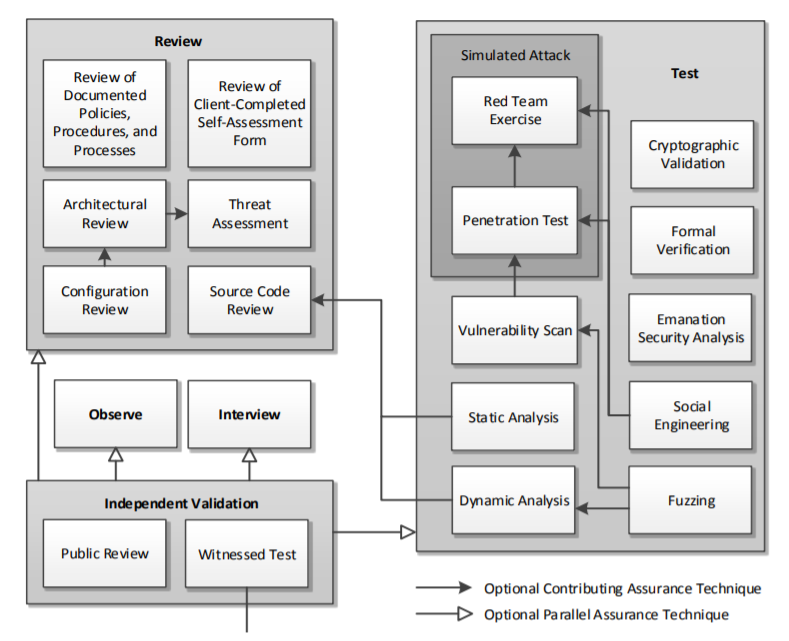
The least suitable techniques in this case may be testing techniques, such as penetration testing and vulnerability scans, as any issue caused by this more active assurance techniques will entail a risk of information loss and infrastructure unavailability.
You could consider the actual context and domain of the organisation (eg testing the security of a normal IT system is not the same as a nuclear power plant). In particular, if has a web-based application, so one could consider potential ways in which attackers might exploit it.
Also, you may need to check for social engineering, for instance with regard to those custodians of the paper-based records.
Then, from the available possibilities, the most cost-effective ones should be chosen: that is, those with the lowest cost of performing them but which are most effective at discovering vulnerabilities.
Risk Assessment and Management
Risk Register:
- the threats and the vulnerabilities they might exploit
- the assessed impact and likelihood, and the overall risk calculated from these
- the recommended treatment (accept, avoid, reduce, transfer)
- the actual action(s) to be taken and the person or department responsible for carrying out this work and the date by which it is expected to be completed.
Qualitative Risk Assessment
A qualitative risk analysis prioritizes the identified project risks using a pre-defined rating scale. Risks will be scored based on their probability or likelihood of occurring and the impact on project objectives should they occur.
- Qualitative probabilities (Likelihoods)
- Qualitative/Quantitative Impact
Risk = Likelihoods (Threat x Vulnerability) x Impact
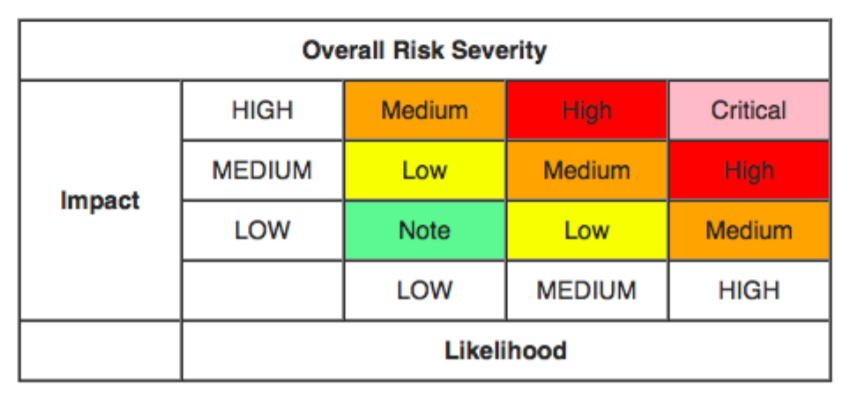
Quantitative Risk Assessment
A quantitative risk analysis is a further analysis of the highest priority risks during a which a numerical or quantitative rating is assigned in order to develop a probabilistic analysis of the project.
The Annualized Rate of Occurrence (ARO) is a business-friendly measure of the probability of occurrence of an event that measures how likely an event is to happen during a year.
The Annual Loss Expectancy (ALE) is a business-friendly measure of a risk in a quantitative risk assessment approach. It is calculated based on the annual rate of occurrence (ARO) and the single loss expectancy (SLE) for each risk.
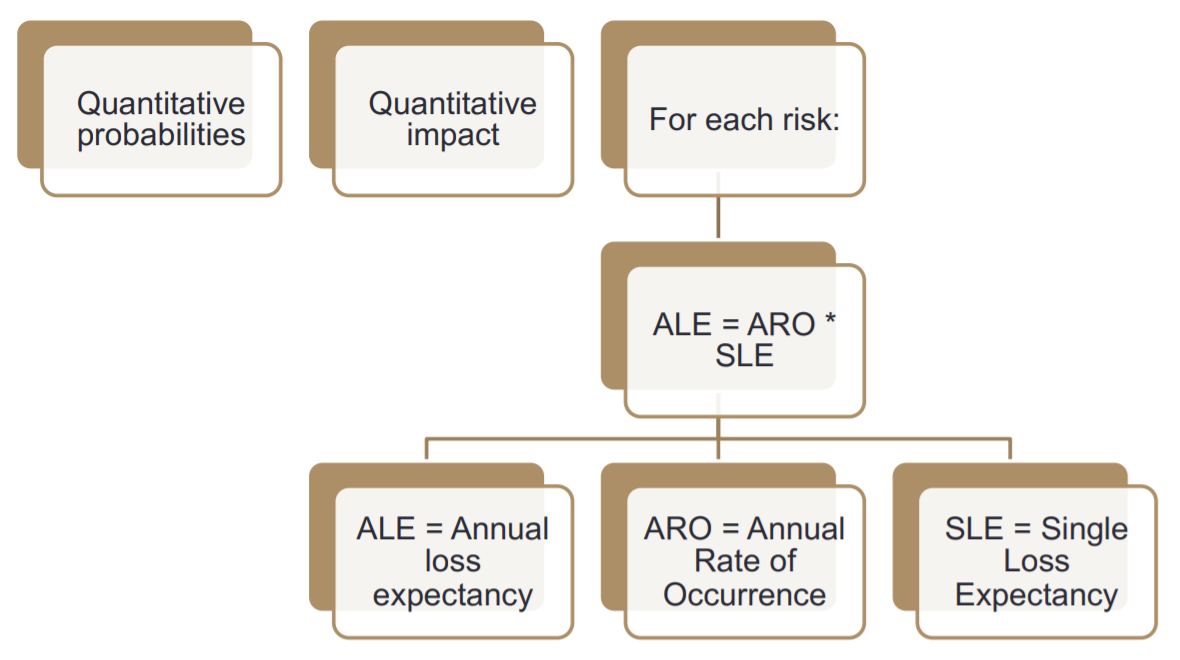
Risk Treatment and Monitoring
Risk Treatment
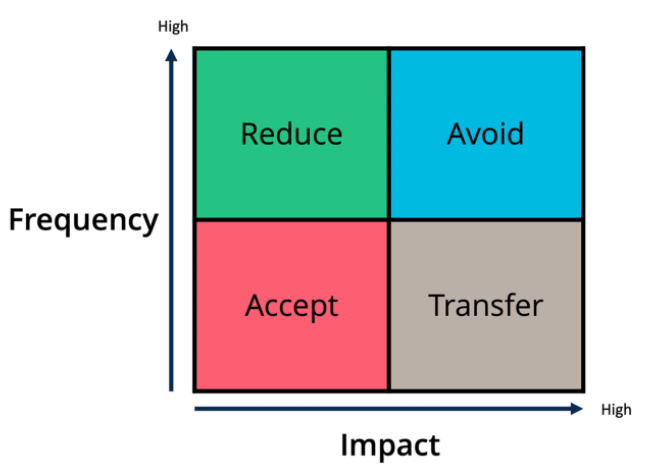
- Avoid
Not doing something that incurs risk. That is, to not do or to stop doing a business activity because it puts the organisation at too much risk. - Accept
The organisation is willing to live with or tolerate the risk. - Reduce
This is when security controls are applied to reduce the risk.- Reduce the threat
- Reduce the vulnerability
- Reduce the impact
- Transfer
This is where the risk is passed on to another entity or organisation.-
Outsourcing:
Risk is moved to a third party when the relevant expertise to manage the risk is not available within the organisation. -
Insurance policy:
This is an especially appropriate method when the impact of the risk can be measured as a purely financial one and is estimated to be high.
-
Risk Monitoring
The frequency of monitoring may vary according to the type of threat:
- some threats may change very quickly and will require monitoring at frequent intervals
- others, however, will change little over long periods of time and will only need occasional monitoring.
The whole risk management cycle should be repeated over time, as some threats might disappear completely and new threats might emerge. The interval will depend largely upon the risk appetite of the organisation and may well be documented in a risk management strategy or policy document.
Challenge for Risk Management
- Unanticipated threats
- AI
Key issue in Adversarial ML: bad actors will attempt to exploit the ML model itself- Evasion attacks: Attacks on ML, where malicious objects are deliberately transformed to make a ML model make wrong predictions. For instance, a software binary can be manipulated to make a machine-learning based anti-malware model predict that it is not malware.
- Supply chains
Security Organisation, Policies, and Compliance
Security Culture
Information Security is more than just technical countermeasures. It is as much about people as it is about anything else. People have to be educated, motivated and appropriately regulated.
New CISO
Responsible for protecting their organisation’s computers, networks and data against threats, such as security breaches, computer viruses or attacks by cyber-criminals.
Four faces
- Technologist
- Guardian
- Strategist
- Advisor
Challenges
- Narrow perspective
- Communications and collaboration
- Talent shortage
- False sense of security
- Competing agendas
CISO Position
The CISO should ideally be part of the board of directors of GANT. This is due to a number of reasons, which we could divide into two categories:
Authority within the organisation
- It will ensure that the CISO is seen as a senior role, demonstrating from the ‘higher-ups’ a real commitment to Information Security in GANT.
- A director or board member has the necessary status to ensure appropriate focus is placed on Information Security.
- Sarbanes-Oxley (USA) and The Companies Act (UK) also require this level of accountability/responsibility.
External incentive
- There is a responsibility to ensure adequate service continuity requirements are in place. Therefore, if there is a major problem, the company won’t go out of operation.
- If measures are not properly implemented, the accountable person can face a custodial sentence.
Security Roles
-
System administrator
A person who manages the operation of a computer system or a particular electronic communication service. -
Security auditor
A person who works with a company to provide an audit of security systems used by that company. -
System user
A person who interacts with a system, typically through an interface, to extract some functional benefit. -
Incident response member
A person who is part of the incident response team. They are responsible for resolving incidents as they arise. -
Security champion
A person who is appointed to oversee the enforcement of security policies within their group and to report incidents to management. -
Security officer/guard
A person employed by the organisation to protect the assets from a variety of hazards by enforcing preventative measures.
Security Policies
Policy
A high-level statement of an organisation’s values, goals and objectives in a specific area.
A policy doesn’t say how it should be implemented, but it states the end-goal.
Standard
More prescriptive than a policy, a standard quantifies what needs to be done and provides consistency in controls that can be measured.
Designed to support policy and states what must be done and how it should be achieved.
Procedure
A set of detailed working instructions that describe what, when, how and by whom something should be done.
Guideline
Guidelines provide advice, direction and best practice in instances where it is often difficult to regulate how something should be done.
Compliance
Check compliance
- Risk management
- security policies and control
- Reports of breaches/incidents
Externally imposed requirements
Risk assessment and management are key elements that inform the security policy hierarchy, but they are not the only ones. For instance, an organisation also needs to comply with external requirements.
Statutory requirements
Statutory requirements are legal requirements that must be fulfilled. For instance law enforcement agencies must be contacted should certain laws be broken or are suspected of being broken. The downloading of child pornography would be such a case. Compliance with these requirements may influence how an enterprise’s incident reporting procedures are organised. For example how, when and by whom should the authorities be contacted? Privacy legislation such as the Data Protection Act will influence how information is stored and managed within the enterprise and how resources are deployed to ensure that it complies with this legislation.
Regulatory requirements
Regulatory requirements are often imposed by trade bodies, and they specify how an enterprise should operate to conform to certain standards. Although they are not legal obligations, regulatory bodies have extensive powers, and failure to comply could lead to possible fines or, in extreme cases, exclusion from trading in a particular environment. The finance sector is a good example of this as it maintains strict controls to prevent financial malpractices such as fraud or money laundering.
Advisory requirements
Advisory requirements may arise from government agencies or utility companies and may provide advice as to what arrangements should be put into place to help cope with instances such as fires, natural disasters and acts of terrorism. These requirements are not legally binding and are generally issued to help encourage best practice.
Security Controls
Preventative security attempts to stop an exploit from being exploited.
Detective security tries to discover if an attack is underway.
Reactionary tries to respond to an attack and reduce its impact.
Types
- Technical
- Procedural
Procedural controls are those controls that cover the rules, regulations and policies that an organisation puts in place to help reduce the risk of issues arising. An example is a Clear Screen and Desk Policy. - Physical Physical controls rely on the presence of physical limitations to the activities that a criminal or other unauthorised person may wish to carry out.
Adequate level of protection
First of all, recall that any decisions on the security controls to be implemented should be based on a risk analysis. In this case, there is a need to balance the risk of malware against the costs of purchasing and implementing countermeasures.
A good starting point would be to:
- have a combination of anti-virus and personal firewall programs on each PC that has a connection to the internet or is networked to another computer that does
- choose a product that will also restrict the executables that will run on that computer to a known list of authorised products
- change all the default settings in operating systems, applications and browsers, for example passwords, configurations, open ports and so on, to make it harder for malware to compromise the computer
- apply patches to the operating system and applications promptly
- have a backup policy in place.
Other countermeasures could also be considered depending on the financial capability of GANT (eg network firewall or IDS, etc).
Relevant legislation for Security Control
Legislation applies to all types of security controls: technical, physical and procedural. Whether writing policy, designing CCTV or other monitoring systems, procuring storage and backup from third parties, everything needs to be checked against relevant legislation.
Privacy laws exist to protect the rights of individuals.
The rights of employees are also vital to consider.
Finally, it is worth emphasising that most of the time when gathering information we care only about the meta-data (data about data), not the data itself.
Cloud Computing Security
The practice of using a network of remote servers hosted on the Internet to store, manage, and process data, rather than a local server or a personal computer.
Cloud computing is the practice of using a network of remote serves hosted on the Internet to store, manage, and process data, rather than a local server or a personal computer. It is useful as it allows a small company to gain access to powerful computers that would normally be out of reach.
Legal implications: They must consider the physical location of services (Data Protection Rules), access to information (cloud provider can read all data), if GANT can audit the cloud provider (verify if the cloud is keeping the data secure) and legal issues around the cloud providers sub-contractors.
Security Risks: Cloud providers can be hacked and the information is leaked publicly. This is an example of risk-sharing as while the cloud provider is liable - the data leaked can be embarassing to the organisation. Also the data can be deleted/lost if the cloud provider suffers a crash and does not keep regular backups. Or the data could not be deleted completely when needed.
Data Deletion: Multiple copies of data; Virtualization; Multiple users (Data gets tangled together); Multiple components; Multiple logical layers; Underlying hardware (E.g., Different storage media - SSDs); Third-party and Offline backups (- e.g., other services / tapes)
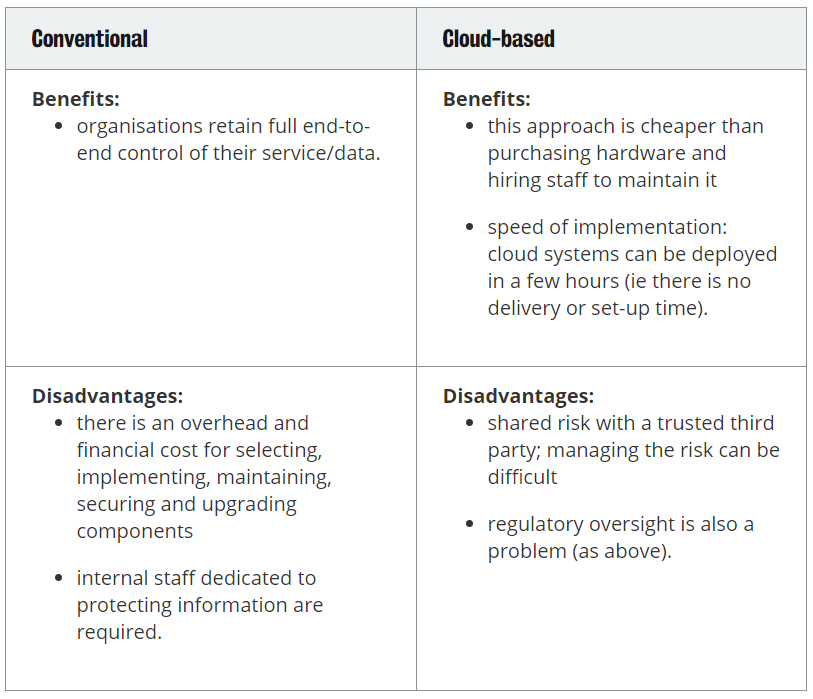
Security Economics
Moral Hazard
A moral hazard is a situation in which one party gets involved in a risky event knowing that it is protected against the risk.
In Information Security, this would apply when people engage in activities that can cause an Information Security risk thinking they are somehow protected.
For instance, one may engage with riskier and less secure websites thinking that the anti-malware they have installed will protect them.
Market for Lemons
The market for lemons was an example introduced by Akerlof (Noble prize winner) in 1970 to explain the concept of asymmetric information in economics.
It presents the following simple yet profound insight: suppose that there are 100 used cars for sale in a town: 50 well-maintained cars worth 2000 dollar each, and 50 lemons (said of a car that turns out to have several manufacture defects not apparent to the buyer) worth 1000 dollar. The sellers know which is which, but the buyers don’t. What is the market price of a used car? You might think 1500 dollar; but at that price no good cars will be offered for sale. So the market price will be close to 1000 dollar. This is one reason poor security products predominate. When users can’t tell good from bad, they might as well buy a cheap antivirus product for 10 dollar as a better one for 20 dollar, and we may expect a race to the bottom on price.
Business Continuity Management (BCM)
Business continuity management (BCM) is a holistic management process that identifies potential impacts that threaten an organisation and provides a framework for building resilience and capability for an effective response that safeguards the interests of its key stakeholders, reputation, brand and value creation activities.
Business Continuity Plan
- Assigning responsibilities
- Senior management must approve the plan.
- Likely an appointment at boardroom or executive level to oversee, and an appointment to take the programme forward.
- Establishing and implementing the plan
- Scope, aim and objectives, and the activities required if the plan is triggered, i.e. What are the likely problems that will pop up? How can we deal with them?
- Ongoing management
- Regular review of the continuity plan (i.e. it can easily become out of date and no longer reflect real business operations). Similar to the Plan-Do-Check-Act model.
In order to create an effective business continuity plan, we need to:
- understand the organisation and its risks, so this relates to risk management and assessment as seen in this module in previous weeks
- determine the BCM strategy, identifying the actions needed to maintain critical activities to support the organisation’s products and services
- develop and implement the BCM response, which includes answering questions such as: How do we meet our expected recovery times? What tactics can we deploy to protect resources?
Business impact analysis
Business impact analysis predicts the consequences of disruption of a business function and process, and gathers information needed to develop recovery strategies.
First, list products that could be disrupted and for each identified product, consider the impact of disruption in terms of stakeholders and the organisation’s ability to meet its aims and objectives.
Secondly, we need to figure out what the maximum length that the disruption can be managed without interrupting the business is. In other words, if a service or a product is disrupted, how long will it take for the disruption to be felt by the business in terms of profit, reputation, etc.
We also need to identify the recovery time objective (RTO), which is a point in time at which each key product or service would need to be resumed in the event of a disruption.
Finally, we need to identify the critical activities necessary to deliver the products and services. These are the activities that we need to protect and in order to do that we need to quantify the resources (people, premises, technology, information, suppliers, etc) required over time to maintain these activities at an acceptable level to and meet our RTO.
Developing and implementing the busines continuity plan
- incident management
- business continuity
- business recovery
Outline:
- Purpose, scope and content
- Document maintainer
- Plan invocation
The method by which the plan is invoked should be clearly documented, setting out the individuals who have the authority to invoke the plan and under what circumstances. The plan should also set down the process for mobilising and standing down the relevant teams. - Roles and responsibilities
- Incident management
Document the required tasks to manage the initial phase of
the incident and who is responsible for each task. The tasks include:
- site evacuation and mobilisation of safety
- first-aid or evacuation-assistance teams
- locating and accounting for those who were on site and the immediate vicinity
- ongoing employee and customer communications and safety briefings
- up to date contract list and location of plan
- identifying robust rooms to manage the incident.
- Business continuity and recovery
In terms of business continuity and recovery the plan should:- set out the critical activities to be recovered
- the timescales in which they are to be recovered and the needed recovery levels
- the resources available at different points in time to deliver your critical activities
- the process for mobilising these resources and the detailed actions needed to ensure the continuity and recovery of your critical activities.
The plan must be exercised regularly in order to ensure that arrangements are reliable.
Discussion based exercises
Bring staff together and inform them about their responsibilities. Discuss with staff to identify problems and solutions.
Testing
Not everything can be tested, however, you can consider the contact list, activation process and the relied upon hardware such as communication lines, power supply, etc.
Table-top exercise (ie think board games)
In this exercise, you bring staff together around a table to make decisions as events unfold in the same way as if the incident actually happened. This can take between a couple of hours and half a day. The benefit of this format is that it can generate high levels of realism and lets everyone know each other.
Live exercise
Live exercises are necessary for some components such as evacuation that cannot be tested effectively in any other way. While single component tests are relatively simple to set up, full tests are much more complex and can be costly.
Disaster recovery
Main goals
- To minimise interruptions to the normal operations
- To limit the extent of disruption and damage
- To minimise the economic impact of the disaster
- To establish means of operations in advance
- To train personnel in emergency procedures
- To provide smooth and rapid restoration of services
Recovery Plan Contents
-
Introduction
A summary of the objectives and scope of the plan, including IT services and locations covered, the different services, and testing and maintenance activities. Also includes a revision history to track changes. - Roles and responsibilities
A list of the internal and external stakeholders involved in each DR process covered, complete with their contact details and a description of their duties. - Incident response When should the DR plan be triggered, and how and when should employees, management, partners and customers be notified?
- Disaster recovery procedures
When the plan is triggered, the stakeholders can start to action the process for each affected IT service. These processes have to be set out step by step. - Appendices A collection of any other lists, forms and documents relevant to the DR plan, such as details on alternate work locations, insurance policies, and the storage and distribution of DR resources.
BCM and DR
Disaster recovery is that part of business continuity that addresses the need to recover IT services and voice services and data following a business-threatening impact.
Disaster recovery prioritises those services and information that are critical to the business. Disaster recovery includes planning for crisis situations and having in place the means to identify incidents, contain and recover them.
Usable Security
According to the computing research association, usable security is “Give end-users security controls they can understand and privacy they can control for the dynamic, pervasive computing environments of the future”. One example could be the indicators in browsers about whether a connection is secure (HTTPS) or insecure (HTTP).
- Make it “just work”
- Invisible security
- Make security understandable
- Make it visible
- Make it intuitive
- Use metaphors that users can relate to
- Train the user